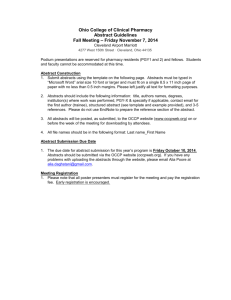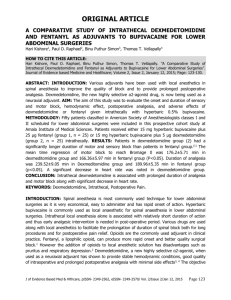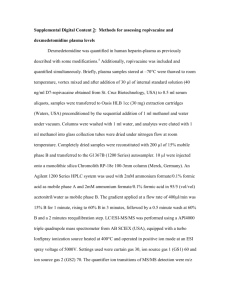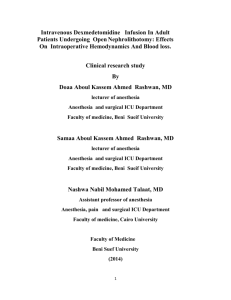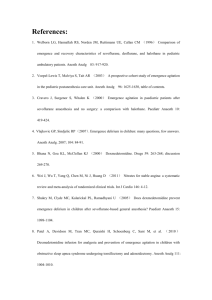A Double Blind Controlled Study
advertisement
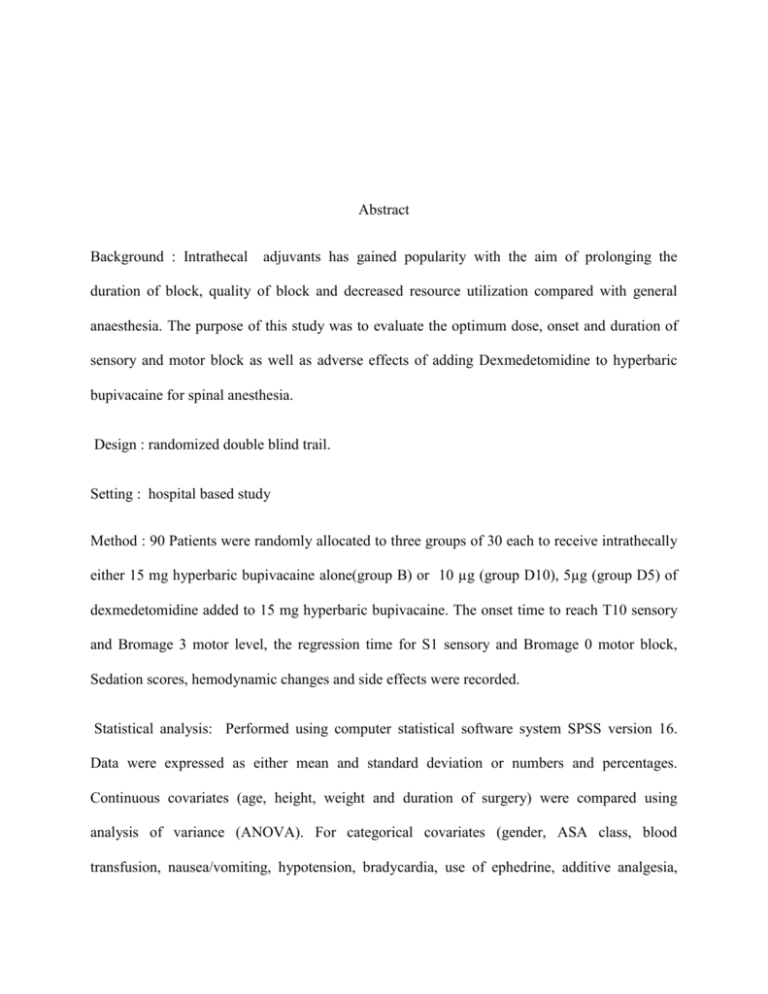
Abstract Background : Intrathecal adjuvants has gained popularity with the aim of prolonging the duration of block, quality of block and decreased resource utilization compared with general anaesthesia. The purpose of this study was to evaluate the optimum dose, onset and duration of sensory and motor block as well as adverse effects of adding Dexmedetomidine to hyperbaric bupivacaine for spinal anesthesia. Design : randomized double blind trail. Setting : hospital based study Method : 90 Patients were randomly allocated to three groups of 30 each to receive intrathecally either 15 mg hyperbaric bupivacaine alone(group B) or 10 µg (group D10), 5µg (group D5) of dexmedetomidine added to 15 mg hyperbaric bupivacaine. The onset time to reach T10 sensory and Bromage 3 motor level, the regression time for S1 sensory and Bromage 0 motor block, Sedation scores, hemodynamic changes and side effects were recorded. Statistical analysis: Performed using computer statistical software system SPSS version 16. Data were expressed as either mean and standard deviation or numbers and percentages. Continuous covariates (age, height, weight and duration of surgery) were compared using analysis of variance (ANOVA). For categorical covariates (gender, ASA class, blood transfusion, nausea/vomiting, hypotension, bradycardia, use of ephedrine, additive analgesia, atropine and type of surgery) a Chi-square test was used, with the p value reported at the 95% confidence interval. For the time to reach T10 dermatome, Bromage 3 scale, and the regression of the sensory block to S1 dermatome and Bromage scale 0, ANOVA test was used to compare the means. The level of significance used was p<0.05. The total sample size was calculated to be 90 (30 patients in each group). Results: Onset of bromage 3 motor block and time to reach T10 sensory dermatome level was statistically significant between group B and group D5, D10 (P <0.05, B vs D5,D10 ). The time for regression of sensory block to S1 dermatome and bromage 0 motor block was increased by addition of dexmedetomidine in a dose dependent manner. (p <0.001, B vs D5,D10. D5vsD10). Conclusion: There is a dose dependent prolongation of sensory and motor block regression time with the addition of Dexmedetomidine up to 10 µg as an adjuvant without any significant increase in the side effects. Keywords: Dexmedetomidine, bupivacaine, spinal anesthesia, intrathecal, adjuvant. INTRODUCTION Lower limb surgeries are mostly performed under spinal anaesthesia. It has the advantage of being free from the risks of intubation but its duration of action is limited. Various intrathecal adjuvants to local anaesthetics have found to improve the quality and extend duration of spinal block. Dexmedetomidine is a highly selective α2-adrenergic agonist which has been used as pre-medication and as an adjuvant to general anesthesia. [1]. Dexmedetomidine have several beneficial actions during perioperative period. They decrease sympathetic tone with attenuation of the neuroendocrine and haemodynamic response to anaesthesia and surgery, reduce anaesthetic and opiod requirement, cause sedation and analgesia. Dexmedetomidine was first introduced into clinical practice as a short term intravenous sedative in intensive care [2, 3]. Like any other adjuvant dexmedetomidine is not free from adverse effects. Use of dexmedetomidine is often associated with a decrease in heart rate and blood pressure [4] Various animal studies have been conducted using intrathecal dexmedetomidine at a dose range of 2.5 to 100 µg without any neurological complications [5,6,7]. Antinociceptive effect of dexmedetomidine ,a highly selective alpha 2 adrenergic agonist was evaluated in animal studies [8,9]. Dexmedetomidine was used to enhance the analgesic property of local anaesthetics like lidocaine, bupivacaine and ropivacaine. In vivo and in vitro studies indicated that these local anaesthetics had significant neurotoxicity [10]. Dexmedetomidine showed protective or growth promoting properties in tissues, including nerve cells from cortex. Dexmedetomidine helps in the prevention of local anesthetic induced neurotoxicity when used together with local anesthesia agents. [11,12] Clonidine, another alpha 2 adrenergic receptor agonist with a 200:1 ratio of alpha2:alpha1 receptor binding has been widely used as analgesic adjuvant for pain therapy. Clonidine is extensively used intrathecally at a dose range of 15 -150 µg as an adjuvant to local anaesthetic agents [13,14]. In 1990s dexmedetomidine a highly selective alpha 2 agonist with a 1600:1 ratio of alpha2:alpha1 receptor binding (8 -10 fold stronger binding then clonidine) was introduced as a short term intravenous sedation in intensive care [3,14]. Even after extensive study of both the drugs the optimal dose of clonidine and dexmedetomidine remains unknown. [13] Methods This study was a randomized, prospective, comparative study. After obtaining the Ethical Committee approval and written informed consent, 90 patients ASA (American Society of Anesthesiologists) grade I-II scheduled for lower limb surgeries were enrolled for the study. Patients using beta blockers, calcium channel blockers, angiotensin converting enzyme inhibitors, or noted to have dysrhythmias on the electrocardiogram (ECG), a body weight of more than 100 kg, or height less than 150 cm were excluded from the study. Premedication was avoided to the study group patients prior to surgery. Standard monitoring was used, including non-invasive arterial blood pressure (BP), ECG, heart rate (HR) and pulse oximetry (SpO2). Preloading was done with 10 ml/kg of crystalloid solution. With the patient in the sitting position, spinal anesthesia was performed at the level of L3-L4 through a midline approach using a 25-gauge Quincke spinal needle which was inserted with the bevel pointing upwards. Patients were randomized into three groups using sealed envelope technique. The dose of hyperbaric 0.5% bupivacaine, 15 mg (3.0 ml) and total spinal volume (3.5 ml) was identical in all study groups. Patients allocated to group D5 received 3 ml hyperbaric 0.5% bupivacaine 15 mg + 0.5 ml of preservative free normal saline containing 5 µg dexmedetomidine. Patients allocated to group D10 received 3 ml hyperbaric 0.5% bupivacaine 15 mg + 0.5 ml of preservative free normal saline containing 10 µg dexmedetomidine. Patients allocated to group B received hyperbaric 0.5% bupivacaine 15 mg + 0.5 ml preservative free normal saline. The intrathecal drug formula (total volume 3.5 ml) was prepared by a separate anesthesiologist under a sterile technique. The anesthesiologist performing the block recorded the baseline value of vital signs (BP, HR, SpO2,) before performing the spinal anesthesia, and once in every 5 minutes inside the O T, then after every 15 minutes in the Post Anesthesia Care Unit (PACU) till the recovery of sensory and motor function. For the purpose of the study, hypotension was defined as a systolic blood pressure of <90 mm Hg and Bradycardia was defined as HR <50 beats/minute. The sensory dermatome level was assessed by pin prick sensation using 23 gauge hypodermic needle along the mid clavicular line bilaterally. The motor dermatome level was assessed according to the modified Bromage scale: Bromage 0, the patient is able to move the hip, knee and ankle; Bromage 1, the patient is unable to move the hip, but is able to move the knee and ankle; Bromage 2, the patient is unable to move the hip and knee, but is able to move the ankle; Bromage 3, the patient is unable to move the hip, knee and ankle. The sensory level and Bromage scale were recorded pre-spinal injection and every two minutes after the spinal injection up to the 10th minute and after that every 3 minutes until the highest dermatome was reached. In the PACU, the sensory level and Bromage scale were recorded every 15 minutes until the patient was discharged from the PACU. All durations were calculated considering the time of spinal injection as time zero. When sensory levels of anesthesia were not equal bilaterally, the higher level was used for the statistical analysis. Patients were discharged from the PACU after sensory regression to the S1 segment, and Bromage scale of 0. No premedication was given to the study patients on the previous night of surgery. The level of sedation was evaluated just before surgery, intra operatively and post-operatively every 15 minutes using the Ramsay sedation scales: scale 1 - patient anxious, agitated, or restless; scale 2 patient cooperative, oriented, and tranquil alert; scale 3, Patient responds to commands; scale 4, Asleep, but with brisk response to light glabellar tap or loud auditory stimulus; scale 5 - Asleep, sluggish response to light glabellar tap or loud auditory stimulus and scale 6- asleep, no response. Patients neurological assessment was done every day and recorded during hospital stay. Results 90 patients were enrolled in the study. All the patients completed the study protocol and were included in the data analysis. Thus group B, group D5 and group D10 consisted of 30 patients each. There was no significant difference in the demographic data between the three study groups [ p >0.05] (Table 1). Table 1: Demographic data (mean±SD) in three study groups. Demographic data B D5 D10 P value significance AGE 35.2 ± 11.8 36.5±12.2 37.8 ± 10.6 >0.05 NO Male 17 17 18 >0.05 NO Female 13 13 12 >0.05 NO ASA Grade I 23 24 25 >0.05 NO ASA Grade II 7 6 5 >0.05 NO Height 160±6 162±8 161±7 >0.05 NO Weight 66±8 65±7 62±5 >0.05 NO Orthopedic surgery 25 26 24 >0.05 NO General Surgery 5 4 6 >0.05 NO The time to reach T10 sensory dermatome, Bromage 3 scale were statistically significant between group B and group D5, D10 but comparable among D5 and D10 groups. The regression of the sensory block to S1 dermatome and motor block to Bromage scale 0 were affected by the addition of Dexmedetomidine to the spinal bupivacaine in a dose dependent manner. Table 2: sensory, motor block onset and regression time in minutes(mean ± SD) Group B D5 D10 P value significant Time to reach T10 4.7±1.1 3.5±0.8 3.1±0.5 <0.05 yes Time to Bromage 3 5.6±1.4 4.4±1.2 3.9±1.0 <0.05 yes Time to reach S1 179.2±22.9 249.6+26.8 340.2±42.9 <0.001 yes Time to Bromage 0 149.4±17.5 225.0+23.3 302.1±31.5 <0.001 yes . The median and range of Highest sensory level recorded were T5 T4 -T7) in group B, T4 (T3T7) in group D5, T5 (T4 –T8) in group D10 were statistically comparable (p>0.05) among three study groups. The total amount of fluids administered following spinal anesthesia, the duration of surgery, amount of ephedrine or atropine, bradycardia, hypotension, need of additive analgesia, blood transfusion, shivering and nausea or vomiting in the intraoperative or in PACU were comparable in the three groups; p>0.05 (Table 3). Values are in mean ± SD. Table 3 : perioperative characteristics (mean±SD) in three study groups. Perioperative B D5 D10 P value significance characteristics Intravenous fluid(ml) 1146.7±251.5 1310.0+236.7 1163.6±251.3 >0.05 NO Duration of surgery 92.9 ± 27.0 98.4±32.5 >0.05 NO Blood Transfusion 0 0 0 >0.05 NO Additive analgesia 0 0 0 >0.05 NO PONV 1 0 0 >0.05 NO Bradycardia 2 1 2 >0.05 NO Hypotension 1 0 1 >0.05 NO Atropine 2 1 2 >0.05 NO Ephedrine 1 0 1 >0.05 NO Respiratory depression 0 0 0 >0.05 NO Shivering 0 0 0 >0.05 NO 96.0±24.5 The mean ±SD values of heart rate (H R) and mean arterial pressure (MAP) measured in O T and PACU were comparable between three groups. Figure 1 and 2 show graphical representation of H R and MAP measured during 1 st hour of study. Figure 1: heart rate measured during 1st hour. (Mean±SD) Time –x axis, heart rate – y axis. Figure 1 show the (mean ± SD) HR in the OT measured during 1st hour, showing no significant difference among the groups. H R was comparable among three groups in PACU as well. Figure 2: Mean arterial pressure measured during 1st hour (Mean±SD) Time – x axis, MAP –y axis Figure 2 shows the (mean ± SD) MAP in the OT measured during 1st hour, showing no significant difference among the groups .MAP values were comparable among three groups in PACU also Ramsay sedation score was 2 in all the study subjects during their stay in O T and PACU .The SpO2 was higher than 95% in all patients in the three groups both in the intraoperative and in the PACU. Study patients did not show any neurological impairment related to spinal anesthesia such as back, buttock or leg pain or weakness, headache or any new neurological deficit. No patients suffered from respiratory depression or shivering during the study . Discussion Prolongation of duration of spinal block is desirable both for long procedures and for postoperative pain relief. Different agents, such as epinephrine, phenylephrine, adenosine, magnesium sulfate, and clonidine have been used as adjuvant for prolonging the duration of spinal anesthesia. The mechanism by which intrathecal alpha 2-adrenergic agonists prolong the motor and sensory block of local anesthetics is not clear. It may be an additive or synergistic effect secondary to the different mechanisms of action of local anesthetic and alpha 2 adrenergic agonist. The local anesthetics act by blocking sodium channels, whereas the alpha 2 adrenergic agonist acts by binding to pre synapyic C fibre and post synaptic dorsal horn neurons. Intrathecal alpha 2 adrenergic agonist produce analgesia by depressing the realease of C fibre transmission by hyperpolarization of post synaptic dorsal horn neurons.[15] Li et al observed that Glutamate is involved in excitatory neurotransmission nociception and plays an essential role in relaying noxious stimuli in the spinal cord. Intrathecal injection of alpha 2 adrenergic agonists produces potent antinociceptive effects by altering spinal neurotransmitter release and effectively treats acute pain[15 16]. Dexmedetomidine was used in a smaller doses in the spinal block combined with bupivacaine, leading to fast onset and prolongation of block without any significant hemodynamic instability or sedation [17,18]. Kanazi et al18 showed that dexmedetomidine (3 µg) and clonidine 30 µg have an equipotent effect. Most of the previous clinical studies involved in the use of intrathecal alpha 2-adrenergic agonists have been described with clonidine. Varying dose of clonidine (15 – 150 µg) was used intrathecally as an adjuvant with local anaesthetic agents. [13] Largest dose of dexmedetomidine used intrathecally in humans was 10 µg. [19] .Previous Studies revealed haemodynamic stability with 5 and 10 µg of dexmedetomidine as intrathecal adjuvant. [17,19]. Rajni gupta et al [20] found intrathecal dexmedetomidine (5 µg) with bupivacaine is associated with prolonged motor and sensory block, haemodynamic stability and statistically significant sedation score . Kanazi et al [18] found that the supplementation of bupivacaine (12.0 mg) spinal block with dexmedetomidine (3 µg) produces significantly shorter onset of motor block, and a significantly longer sensory and motor block with preserved haemodynamic stability and lack of sedation. Al-Mustafa et al [19] compared the doses of dexmedetomidine 5 , 10 µg in isobaric bupivacaine 12.5mg (total volume:3 ml) with plain isobaric bupivacaine without premedication and found the effect to be dose dependent on the onset and regression of sensory and motor block with comparable sedation scores among three groups. In our study with the usage of 5 µg and 10 µg of intrathecal dexmedetomidine with 15 mg hyperbaric bupivacaine ( total volume :3.5 ml) there is a prolongation of duration for regression of sensory and motor block in a dose dependent manner which is comparable to Al-Mustafa et al. The onset of sensory block (to T10) and motor block to (bromage3) was statistically significant between group B and group D5, D10 (P<0.05) and is comparable among groups D5 and D10 . The reason for this may be due to differences like type of bupivacaine (isobaric/hyperbaric) and spinal volume injected intrathecally. In our study we did not pre-medicate any patients and got similar Ramsay sedation scores in group D5, D10 and group B which is comparable to Al-Mustafa et al and kanazi et al. . Dexmedetomidine also have anti shivering property and there was no shivering in the entire study group [21] Conclusion In conclusion, addition of dexmedetomidine prolonged the sensory and motor block significantly when used with hyperbaric bupivacaine intrathecally in a dose dependent manner, without increasing the incidence of significant adverse effects. We support the addition of dexmedetomidine up to 10 µg with bupivacaine in spinal anesthesia when prolongation of spinal anesthesia is desired. Addition of dexmedetomidine avoids general anesthesia in few unexpected cases when surgical duration prolongs. We recommend further study in this direction with higher doses of dexmedetomidine. References 1.Martin E, Ramsay G, Mantz J, Sum-Ping ST. The role of alpha2 –adrenoreceptor agonist dexmedetomidine in post surgical sedation in intensive care unit .J Intensive care med.2003 janfeb;18:(29-41) 2. Scheinin B, Lindgren L, Randell T, Scheinin H, Scheinin M. Dexmedetomidine attenuates sympathoadrenal responses to tracheal intubation and reduces the need for thiopentone and perioperative fentanyl. Br J Anaesth 1992; 68: 126-131. 3. Gertler R, Brown HC, Mitchell DH ,Silivious UN. Dexmedetamidine : a novel sedative analgesic agent. Proc (Bayl univ med cent)2001 jan ;14(1):13-21 4 Venn RM, Ground RM. Comparison between dexmedetomidine and propofol for sedation in intensive care unit: patient and clinician perception. B J Anaesth. 20021;87:684-90 5. Shimode N, Fukuoka T, Tanimoto M, Tashiro C, Tokunaga A, Noquichi K. The effect of dexmedetomidine and halothane on fos expression in the spinaldorsal horn using a rat post operative pain module. Neurosci let 2003 May; 29:343(1)45-8 6. O O, Smith LJ. A comparision of epidural analgesia provided by bupiaicaine alone ,bupivacaine +morphine or bupivicaine+dexmedetomidine for pelvic orthopaedic surgery in dogs. Vet anaesth analg 2013 sep; 40(5):527-36 7. Eisenach JC, Shafer SL, Buuckler BA, Jackson C, Kallio A. Pharmacokinetics and pharmacodynamics of intraspinal dexmedetomidine in sheep. Anaesthesiology 1994 Jun;80(6):1349-59 8. Kalso EA, Poyhia R, Rosenberg P. Spinal antinociception by dexmedetomidine, a highly selective α2-adrenergic agonist. Pharmacol Toxicol 1991; 68: 140-143. 9 Asano T, Dohi S, Ohta S, Shimonaka H, Iida H. Antinociception by epidural and systemic alpha 2 adrenoreceptor agonists and their binding affinity in rat spinal cord and brain. Anesth Analg 2000; 90: 400-407. 10 Werdehausen R, Fazeli S, Hollmann MW, Bauer I, Stevens MF. Apoptosis induction by different local anaesthetics in a neuroblastoma cell line. Br j anaesth 2009 nov;103(5):711-8 11 Sanders RD, Sun P, Patel S, Li M, Maze M et al. Dexmedetomidine provides cortical neuroprotection impact on anaesthetic induced neuroapoptosis in rat developing brain. Acta Anaesthesiol scand 2010; 54 :710-716 12 Hongxing Zhang, Fang Zhou, Chen Li, Min Kong, He Liu, Peng Zhang, Song Zhang, Junli Cao ,Licai Zhang, Hong Ma. Molecular mechanisms underlying the analgesic property of intrathecal dexmedetomidine and its neurotoxicity evaluation: an in vivo and in vitro experimental study. PLOS one 2013;8(2):e55556 13 Elia N, Culebras X, Mazza C ,Schiffer E, Tramer MR. Clonidine as an adjuvant to intrathecal local anaesthetics for surgery:systematic review of randamised trails. Req Anesth pain med 2008 mar-apr;33(2):159-67 14 Bischoff P,Kochs E. ALPHA2 agonists in anesthesia and intensive medicine. Anasthesiol intensivmed notfallmed schmerzther13.1993feb;28(1):2-12. 15 Fairbanks CA, Wilcox GL.Spinal antinociceptive synergism between morphine and clonidine persist in mice made acutly or chronically tolerant to morphine.J Pharmacol Exp ther 1999;288:1107-1116 16 Li X, Eisenach JC. Alpha 2A adrenoceptor stimulation reduces capsaicin induced glutamate release from spinal card synaptosomes. J Pharmacol exp ther 2001 dec;299(3):939-44 17. Kim JE, Kim NY, Lee HS, Kil HK. Effect of intrsthecal dexmedetamidine on low dose bupivacaine spinal anaesthesia in elderly patient undergoing transurethral prostatectomy. Biol Pharm bull 2013;36(6):959-65 18. Kanazi GE, Aouad MT, Jabbour-Khoury SI, Al-Jazzar MD, Alameddine MM, Al-Yaman R. Effect of low-dose dexmedetomidine or clonidine on the characteristics of bupivacaine spinal block. Acta Anaesthesiol Scand 2006; 50:222-227. 19 Al-Mustafa MM, Abu –Halaweh SA, Aloweidi AS, Mushidi MM, Amman BA, Awwad ZM, Al-Edwan GM, Ramsay MA. Effect of dexmedetomidine added to spinal bupivacaine for urological procedures. Soudimed j.2009mar;30(3):365-70 20 Rajni Gupta, Reetu Varma, Jaishri Bogra, Monica Kohli, Rajesh Raman, Jithendra Kumar Kushwaha. A comparative study of intrathecal dexmedetomidine and fentanyl as adjuvants to bupivacaine. J Anaesthesiol clin pharmacol 2011jul-sep;27(3):339-343. 21 Talke P, Tayefeh F, Sessler DI, Jeffrey R, Noursalehi M, Richerdson C. Dexmedetomidine does not alter the sweating threshold, but comparably and linearly decreases the vasoconstriction and shivering threshold. Anaesthesiology.1997;87:835-41.
